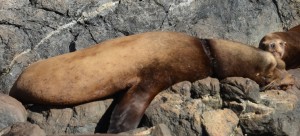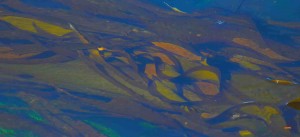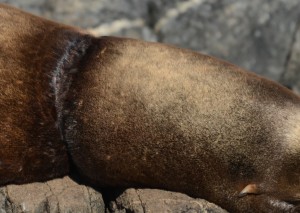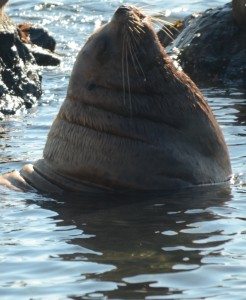Summer continues on Race Rocks with light easterly winds switching around to westerly this evening. It is still clear but there are more clouds tonight than I have seen in a while. Overall the barometer has been slowly dropping since last Thursday yet still remains relatively high. Although there is a gale warning in effect for tomorrow, the winds will be westerlies, which usually means good weather, but may bring in the fog.
Killer Whales to the south and southwest of Race Rocks drew quite a few tour boats again today. A total of fourteen whale watching boats were observed in the reserve, all well behaved. There was no illegal fishing observed.
Another ring-necked, California Sea Lion was photographed today. It appears to be healing although no rehabilitation tags were observed on this animal and it was difficult to tell if the entanglement was still there or not.

This California Sea Lion appears to be recovering from a ring-neck injury. No tags to indicate rehabilitation.
Most of the sea lions hauled out at Race Rocks appear to be in good shape. Here is a photo of a well fed Steller’s Sea Lion.
The total number of Double Crested Cormorants and flock size, seems to go up everyday. Today I saw my first returning Surf Scoters flying in from the west. Rhinoceros Auklets, Common Murres and Heerman’s Gulls are very active around the edges of the reserve. The Heerman’s Gulls sometimes rest on the big rafts of bull kelp.
The Bull Kelp is on its’ way out and is epiphytized with red and green algae. Much of the area on the large blades have gone into zoospore production and the spore patches are clearly visible.

Bull kelp sporophylls are the lighter areas of the blades. This is where millions of zoospores are produced to make the microscopic over-wintering gametophytes.
This last large tidal series has ‘littered’ the tide lines with floating kelp, wood and debris. A dock with a braced super-structure heading out to sea with the tide in Race Passage was reported as a hazard to navigation.
A lot of maintenance work has been accomplished over the last few days. The Jetty exclusion zone is now working well. The science house perimeter is functional. The weed-eater is working well and the compost is mulched in with hay. Many little things are a bit cleaner and tidier than when they were found.

